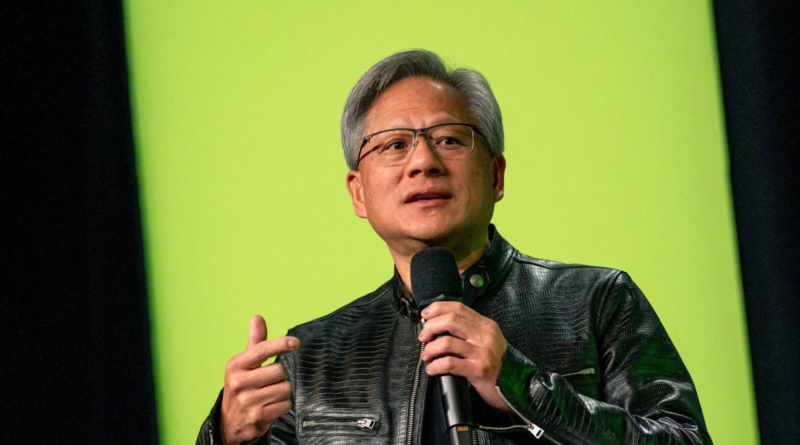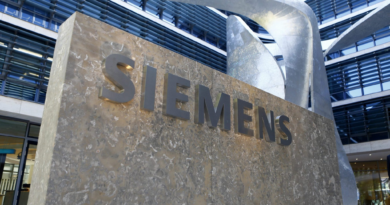Nvidia announces threefold sales increase in another blowout earnings report—‘We’re racing every day,’ says CEO Jensen Huang
Markets breathed a sigh of relief after Nvidia’s long-anticipated earnings report comfortably beat expectations, with revenue up an eye-watering 262% from last year, sending its share price to an all-time high of $1,017 after market close. Driven by massive AI demand, the chipmaker also announced a 10-to-1 stock split, which will make shares more accessible for retail investors and could boost share prices even more.
“The industry is going through a major change,” Nvidia CEO Jensen Huang said on an earnings call Wednesday. “The next industrial revolution has begun. Companies and countries are partnering with Nvidia to shift the trillion-dollar installed base of data centers to accelerate computing and build a new type of data center, AI factories, to produce a new commodity, artificial intelligence.”
Nvidia’s stock has been on a tear over the past year: It’s up 200% in the past 12 months, and up 87% since the beginning of 2024. Its explosive growth has catapulted it to the third-highest market capitalization in the world, above peers including Amazon and Meta. “The most important stock on planet Earth,” per Goldman Sachs, has helped lift the entire S&P 500 to all-time highs, and another earnings beat is a positive indicator that Nvidia doesn’t intend to slow down anytime soon.
Demand for Nvidia’s electric circuits, known as graphics processing units (GPUs), and data centers has been “incredible,” said Huang. The phenomenon is largely due to applications like ChatGPT and GPT-4, in addition to the burgeoning class of AI startups, which Huang estimated to include between 15,000 to 20,000 firms. And that doesn’t account for companies focused on self-driving cars, digital character design, and biotech firms, he said, which has led to still greater need from clients.
“We’re racing every day,” said Huang. “Customers are putting a lot of pressure on us to deliver the systems and stand them up as quickly as possible.”
Over the past year, Nvidia’s had no problem breezing past high expectations: It beat earnings per share estimates by an average of 20% over the prior four quarters before Wednesday’s release. So coming into the earnings report, Wall Street’s expectations were lofty—analysts projected $24.65 billion in revenue. But the $26 billion Nvidia reported was good for a 5.5% beat on Nvidia’s data-center revenue, which makes up the majority of its revenue overall. It came in at $22.6 billion for the quarter, above Wall Street’s $21.13 billion estimate and 427% higher than this time last year. Nvidia’s share price rose as much as 4.4% in aftermarket trading following the earnings release, crossing the $1,000 threshold for the first time during the earnings call.
“If 10 was a shockingly good [result] to the upside, I’d give it a seven or eight,” tech investor and The Citadel finance professor Paul Meeks told Fortune.
Although Nvidia’s 10-to-1 stock split doesn’t have any immediate impact on its valuation, making shares cheaper and more accessible for retail investors is a smart move, according to Meeks. Nvidia’s stock is trading at around $950 at the moment, meaning once the stock splits on June 7, investors will likely be able to get their hands on shares for below $100.
“Stock splits are cosmetic … But as you drive the stock down to about $100 a share, and everyone on planet Earth knows that this is the leading tech stock … I do think that there are probably some retail investors that are champing at the bit to buy it now,” Meeks said. “It’s definitely overall a positive.”
The source of Nvidia’s domination is its massive lead in the AI hardware market. Nvidia pioneered development of GPUs, specialized computer chips it initially used for gaming but then pivoted to market for AI developers as the AI sector has exploded.
Nvidia’s hardware game is backed up by deep investments in software: Its CUDA programming interface, which runs exclusively on its chips, is a must-use for many AI developers, and a key reason why it’s been able to defend its near-monopoly in the AI space.
Nvidia’s rise has been powered by relentless demand: The company’s been forced to pick and choose who gets chips first as everyone from data center operators to startups and Big Tech fights to get their hands on AI computing power, especially its top-of-the-line Blackwell and H200 chips, which the company said it expects to start shipping next quarter.
“Blackwell is in full production … Demand for H200 and Blackwell is well ahead of supply, and we expect demand may exceed supply well into last year,” Nvidia CFO Colette Kress said in an earnings call.
“We will see a lot of Blackwell revenue this year,” Huang added. And, “after Blackwell, there’s another chip.”
Nvidia’s business outside of AI chip development was a relative afterthought. The company’s gaming division, once the core of its business, recorded $2.6 billion in revenue, down 8% from last quarter. Its automotive division recorded gains on $329 million in revenue, but Nvidia’s other business lines paled in comparison to its AI chipmaking investments.
Since the beginning of this year, though, Nvidia’s rivals have been ratcheting up the competition in the AI hardware space. Intel, flush with $8.5 billion in CHIPS Act funding, released its Gaudi 3 AI chip last month, which will compete with Nvidia’s top-of-the-line Blackwell model. Big Tech’s AI developers, including Google and Microsoft, have announced they’re designing their own AI chips in-house to reduce their reliance on Nvidia and cut costs.
“This combination of some of the big companies saying, ‘We’re going to develop our own AI chips,’ and other industries saying, ‘We’re going to do it locally on our smaller devices, for less power consumption’—that might, in the long term, be what hinders their growth,” Edward Wilford, an analyst at tech consultancy Omdia, told Fortune.
Nvidia’s business model isn’t vertically integrated in full: As a chip designer, it creates models for semiconductors but outsources the actual fabrication of its most advanced chips to TSMC, the Taiwanese giant that manufactures over 90% of the world’s advanced chips. Frosty U.S.-China relations and a recent earthquake in Taiwan that briefly shut down TSMC’s headquarters have some Nvidia investors on edge—any significant disruptions to TSMC’s operations would be a big blow to the entire semiconductor supply chain.
“They’ll be highly aware of how susceptible they are to TSMC and supply disruption. They’ll be watching that carefully,” Wilford said. “That’s a business that you can’t just relocate from one area to another … They want to make sure that that’s protected at all costs. That’s going to be something that keeps some people up at night.”




